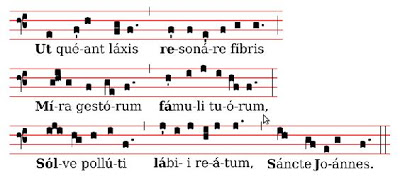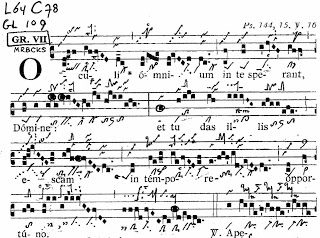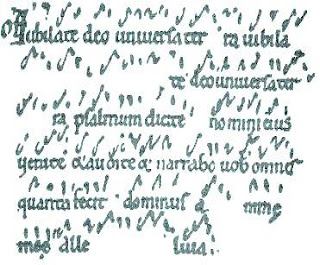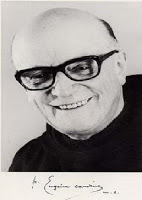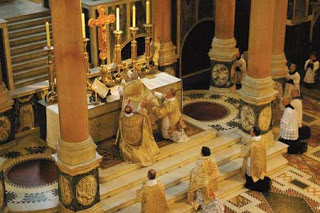
London on Sunday updated


Catholic musicians gathered to blog about liturgy and life

The reason for my journey toward and ardent love of Gregorian chant can be singularly boiled down to this: In Gregorian chant the Word of the Liturgy, the mystical Voice of Christ, is given primacy.
So much of our experience of the liturgy today is focused on musical styles that abstract and take precedence over the liturgical texts, if they are not altogether changed or substituted for something else in the first place. It’s not uncommon for composers who write in more contemporary “pop” musical styles to hack apart phrases, rewrite scriptural passages, omit major sections, obscure word accentuation, even make their own additions to a scriptural or liturgical text, and all of this is done, or so it seems, to meet the demands of the musical style in which they’re writing. Just take a look at musical settings of the psalms in many of today’s hymnals for proof of this. Where is the emphasis? What is given pride of place? In this music is it the Voice of Christ that acts and speaks to us in the liturgy? Or is it distorted by the idiosyncrasies of musical styles?
As Liturgiam Authenticam has said, the text of the liturgy is “…endowed with those qualities by which the sacred mysteries of salvation and the indefectible faith of the Church are efficaciously transmitted by means of human language to prayer, and worthy worship is offered to God the Most High.” (LA, art. 3)
It should be clear that the texts of the liturgy are no ordinary texts!
In a recent debate that I was in with a noted liturgist and “contemporary composer”, he insisted to no end that we should absolutely apply “intellectual property rights” to translated liturgical texts. He insisted that the texts of the liturgy (the carriers of the “sacred mysteries of salvation”, the “indefectible faith of the Church”, by which “worthy worship is offered to God the Most High”) were the “property” of those who translated them, and asserted that to the “owners” of these texts were due copyright royalties, because the texts were their “property”. This is an entirely different subject, and I’m sure it will be discussed amply here, but it should speak to us, I think, a basic truth about the efficacious nature of the texts of the liturgy, and, perhaps it also shows the misunderstanding or even disrespect that we often give them in our modern liturgical practices.
The text of the liturgy gives voice to the Mystical Body of Christ, and is not owned by anyone, but is the inheritance of us all.
The Church’s tradition and wisdom has offered us an exemplary musical model for the singing of the texts of the liturgy, a musical form and repertoire that has given a perfect expression of the Voice of Christ acting in the liturgy in Gregorian chant. Chant offers to the Church a complete musical setting of all of the texts of the liturgy–from the parts that are prescribed for the priest, for the people, to the parts for the choir alone.
The Second Vatican Council states that “The Church acknowledges Gregorian chant as specially suited to the Roman liturgy: therefore, other things being equal, it should be given pride of place in liturgical services.” (SC 116)
The more that I have reflected on the way in which Gregorian chant gives a perfect expression to the Voice of Christ in the liturgy, I have come up with an expanded permutation of this idea:
Gregorian chant is given “pride of place” in the liturgy because the Liturgical Word is given pride of place in Gregorian chant.
In my training in Gregorian chant, from the very beginning, the focus for interpretation was placed first and foremost on the Liturgical Word. The following are a few quotes from the first chapter of “An Introduction to the Interpretation of Gregorian Chant, Volume I: Foundations”, by Luigi Agustoni and Johannes Göschl, translated by Fr. Columba Kelly. I find them to be a fantastic foundation for the singing of Gregorian chant, and a wonderful reflection on the liturgical texts, and on the incarnational theology of the Voice of Christ acting in the liturgy:
The phrase “In the beginning was the word” has an unlimited value when applied to the Gregorian repertory. In fact, the text is the key to understanding both the rhythm and the melody of a Gregorian composition.
(…)
The source, from which the Gregorian melodies originate and are nourished, is the word. In fact, it is the word of the liturgy, a word that possesses a sacramental character according to the statements of the Second Vatican Council, for Christ is present in it, and in it Christ is received. This word of the liturgy, which in the final analysis is always God speaking to us, that is to say, the encounter of the human being with God, finds its highest expression when it can blossom forth in music. This happens in Gregorian chant to an eminent degree.
(…)
The innermost living principle of Gregorian chant is to be found in the Word of God and in the human response to it, both of which are imbedded in the context of the liturgy as an unendingly new sacramental happening that nourishes the life of the Christian community and its members.
(…)
The text [of Gregorian chant] is not something that just happens to be attached to a particular melody but rather the text is a sounded word that has flowered into a musical work. The line does not run from the melody to the text that has been set, but on the contrary the exact opposite. The direction is from the word to its realization in musical sound.
(…)
To deliberately abstract the text from its melody is to deprive Gregorian chant of its very reason for existence and the source of its very life. Word and melody have entered into an indissoluble union. The word lives here in perfect symbiosis with its carrier, the melody.
(…)
Therefore, [in the interpretation of Gregorian chant] the fundamental elements to be taken into account are the following:
1. the word as the primary source of the interpretation;
2. the melody as conditioned by the text and by the modal laws;
3. the neume design as the symbolic representation of the musical form received by the text.
(Excerpts taken from the preface and first chapter of “An Introduction to the Interpretation of Gregorian Chant”, Agustoni and Göschl, 1987, tr. Kelly, 2006.)

More pragmatist than philosopher, I let an itinerant thought take root in m’ noodle and according to one’s POV, this thought is ovulating or metastasizing.
It’s likely that a vast majority of parishes either make the one time investment in a hardbound hymnal, or they subscribe to seasonal and yearly newsprint hymnal/missal products. The vast minority of parishes choose to self-publish weekly orders of music or “permanent parish hymnals” culled from various copyright-governed, common license or public domain sources. Some others make use of the “overhead projection” of power-pointed lyrics, licensed or, uh, otherwise.
So, let’s backtrack to the vast majority and focus upon the subscription-based parishes, such as mine. Here’s the germ idea: We are fortunate to live in a world where if you leave your 50 page, three color, glossy pictured proposal in the cab, you can use your smart phone and have one waiting for you by the time you arrive at the corporate reception desk, at least according to the advert I saw on the TV.
Okay, stay with me. For a modest surcharge, couldn’t the major RC American corporate publishers offer their core market parishes/dioceses a premium offer that allows the crafting of, essentially, boutique hymnals whose content is drawn from the publisher’s existing repertoire holdings, public domain sources and the creative commons sources that are sprouting like dandelions?
Still with me? Okay, let use our parish as a model and I’m the local editor. I’ll try to cut to the chase. First, I lose items in the ordinaries, psalter section (not from the missal section) and the hymnal that, after “pastoral consultation” among my peers and clergy, we concede to be dead-weight. We communicate those itemized decisions to the publisher’s agent and agree upon how many pages of content are now made vacant with a certain percentage of margin for error. Let’s say that I know that I want to include a number of additional chants from the publisher’s stand-alone product that contains such, ie. OCP’s “Laus et Tibi.” Let’s say that over the years the parish has purchased and maintained octavo versions of choral hymn concertatos, liturgical songs and ordinaries that once were included in former yearly editions of their missals, all of which have congregational version plates archived. Couldn’t they be accessed easily and added to the vacant pages?
Let’s say that we still have a surplus of pages and we desire to include hymns, psalms, propers or whatever from either public domain sources such as the ICEL resource hymnbook, or the hymns found in the commons listed on the Musica Sacra website, or other sites similar to the Choral Public Domain Library (a wiki source) of works we find worthy of inclusion that the composers or license holders put “out there” gratis. Once content and layout are finalized, the publisher adds their surcharge to the amended yearly product, and the parish signs on the dotted line, and the publisher sends the master to their printer, and the custom hymnal shows up, bill gets paid, everybody happy!
I realize that all of this could simply be mounted at the parish level. But, I’ve been there. Once. One time. Back in the Seventies. I don’t care how accessible license permission can be obtained now, self-publishing is not in my future. But the Biggies have their protocols and printing companies already tooled-up. If I can order my Chevy Malibu with a heavenly host of options on Monday and it’s ready for delivery the next Monday, can’t the publishing market consider re-tooling for a still lucrative boutique hymnal market. I don’t see a downside for the publishing houses. Now, if I opt not to include Sebastian Temple’s “Take My Hands” in our boutique parish hymnal, maybe there will be a miniscule loss of royalty revenue to his heirs. If I take out all of one composers’ songs, such as that goofball Charles’s tunes, would the revenues lost by our parish subscription amount really affect Charles’ yearly income drastically. Doesn’t Charles have to churn out new product to keep building the profit pyramid? And if that’s good product, won’t my parish want that included in next year’s boutique hymnal?
I’ve been made aware by a publisher’s representative there are many complexities that seriously would apply specific problems to this proposed idea. The pioneer publisher Friends of the English Liturgy (FEL) once had a program wherein parishes could purchase loose-leaf versions of select songs culled from their library in large amounts that would constitute a “parish hymnal.” Also in the early 70’s. Can you say “Edsel?”
But if we cannot ever reach consensus that either a national hymnal (with its own set of issues) will supplant the free market publishers, or that the Graduale Romanum or Gregorian Missal will be mandated by the USCCB/FDLC/BCL – PTB’s, then cannot there be a reasonable, affordable and profitable (in many ways) alternative to the narrow monopoly of options with which we currently contend?
I am approaching the seventeenth anniversary of accepting the duties of Director of Music for my parish. As I retired from teaching choral music at one of our four excellent public high schools (excellence in choral programs particularly) in 2005, I have served the parish as a full-time director for five years now. In the last two and half years our parish and pastor articulated the merger of three other local parishes and missions into the only clustered parish I’m aware of in our diocese. And we’re scheduled to open a fifth, large capacity parish worship facility sometime next year. Because of our central geographical location in the diocese, both the bishop and pastor have articulated plans that will designate the new parish to serve as a venue for diocesan liturgies.
In the last two years plus, my job description has been augmented greatly. And in the last two weeks, after consultations with the pastor, it now has expanded to include being the director of liturgy as well. Our parishes’ administration and organizational flow chart have, out of necessity, been reorganized into departments with cabinet members; Liturgy being one of six departments, and myself as the top of that “food chain” who reports to the pastor.
What has been a striking result, to me, of this administrative change, is that it has already provided me with more substantive collaboration time not only with the pastor, but our parochial vicars and deacons than I’ve ever enjoyed prior. For example, I casually initiated a conversation with “the boss” about various concerns- the progress of fixing a faulty PA system here, the development of new and younger organists and cantors there, Spanish-language music ministry needs, etc., pretty standard stuff. In the conversation I had mentioned to him I had posted an article in our parish website about the Proper processional antiphons that we employ at three of our nine Vigil/Sunday Masses at our “mother” parish. The pastor, who’d previously expressed much appreciation for the choral homophonic settings in English by the great Richard Rice, mentioned his interest in my other Proper sources for the Introit and Communio. He commented that he noticed occasionally that the tessituras and “ornamentation” of the melodies seemed “complex.” And he contrasted that thought by mentioning his personal appreciation for the Owen Alstott Respond and Acclaim “method.” (I’m sure if we’d had Chabanel 17 years ago, he’d have the same sort of appreciation for those.) The importance of this, to me, is that my pastor was opening channels of conversation that previously were taken for granted. He and I discussed other approaches, such as “By Flowing Waters” (he went to seminary with Dr. Paul Ford) and “Psallite” (not a favorite for me personally.) My pastor is not in the least a disinterested liturgist, nor musically prejudiced or under-exposed to all forms of sacred/liturgical music. His regard for Respond and Acclaim’s ethos doesn’t clash with his appreciation for our choir’s performance of the Allegri “Miserere mei” or the chanted Reproaches by Bruce Ford.
What I’m most encouraged by is that we both seem much more at ease with engaging in specifics. From that informal talk yesterday I was provided an opportunity to show him sources of English chant that we use by Fr. Kelly, Fr. Weber, Bruce Ford and the Anglican Use Gradual. I was able to demonstrate their distinct qualities and approaches by comparison to the Latin originals from the GR. He was interested in systematically understanding the different approaches that are evident between Bruce Ford’s text and melodic interpretations and those of Fr. Kelly. He was similarly struck by the “new chant” modalities of Fr. Weber and the AUG. From there we discussed the future of all of our merged parish Masses utilizing Propers, not only from these sources, but by teaching our congregations the basic Psalm tones, and perhaps by the creation of a home-grown gradual that is utilitarian, accessible upon hearing and not banal, such as how he regards much of the Respond and Acclaim product.
We also discussed in these last two days an upcoming Solemn Vespers on the Feast of the Nativity of the Blessed Virgin Mary. He showed great enthusiasm when I showed him Byrd’s “Ave maris stella” for three voices, and an “Ave Maria” by a Philadelphia composer who lived and worked there at the same time our parish’s founder was in seminary and then assigned to St. Ann’s, Philadelphia, before he emigrated west and founded our parish in 1861. And we “sketched” out some musical approaches within the breviary framework together.
This is almost a totally new experience for me, this “freedom” that invites collaboration that reflects more of the “paradigm” ideal that I first heard explained by Professor Mahrt in my first colloquium three years ago.
Of course, I’m supremely aware that there will be many colleagues who would rightly challenge the very notion that Respond and Acclaim is even viable, much less worthy in practice and concept. But this post is not about merit, it is about two veterans (the number of years of my marriage are the same as those of his ordination) who’ve been working with each other for over six years, but have now entered a new, nascent relationship that can only bode well for the “brick by brick” future of our parish worship.
Te Deum laudamus!
The Gregorian Institute of Canada is offering a program from the 12th to the 18th of August. See the site for more information.
This week at Acton University, I was in casual conversation with a professor of theology at a Catholic seminary and the topic of music came up. She did not really know of my activities here or in music at all but when she found out that I had written a book on Catholic music, she asked me a pointed question. “Why do parishes and seminaries continue to sing music that is so obviously inferior to what has come before?”
I asked her to explain what she meant. First she gave provisos that she is not a musician and knows nothing about the topic. Then she went on to describe her gradual discovery that she could pretty much tell if some hymn is suitable for Mass based on its publication date. If it was composed anywhere between 1960 and the current day, it was likely to be silly and thin and not really very serious. It was likely to be a song that just didn’t seem very churchy. In contrast, she said, she has variously sung hymns from the 19th century that are strong and inspiring and seem suitable for reasons she couldn’t entirely identify.
Perhaps you know this narrative well. I’ve heard it dozens of times, even hundreds of times. But she persisted in asking why. Why is it that this inferior music continues to be printed and sung but the great music of the past is not? I thought for a moment and first began with the explanation that this debate between old and new hymns is probably the wrong debate, that we really need to be talking about the problem of all hymns from all times replacing the actual text and music of the Mass centered on the propers and chant ordinaries. This intrigued her; she had not heard this before.
Still, she persisted: given that we are singing hymns, even if we should be singing propers instead, why do we sing these hymns and not better ones? I do understand what she means. In general I think she is correct – with all provisos for the sappy material in St. Gregory Hymnal and the like. In general, she has a point. There are many answers to the question I could give, and even then I’m not sure I know the one most important reason.
And yet, in the end, all issues of culture and taste and the triumph of mediocrity granted, the factor most often overlooked is the issue of copyright. The older hymns are in public domain. The CMAA has made hundreds available for free. But the newer hymns are all held in a proprietary legal arrangement bound up with royalty payments to publishers, writers, arrangers, and composers. That means that the publishers can extract money from congregations, pay their employees, pay whatever is leftover to composers, charge people for using them, license them out to other publishers, and so on.
The entire economic viability of these publishing firms that dominate our parishes is bound up with this state-based regulatory institution. If you doubt it, take a look at the ostentatious display of GIA’s copyright warchest in the back of Gather Comprehensive, for example. Here you find a major driving force behind the strange mystery of the persistence of bad music. None of this music has stood the test of time and most of it will not. That means that there is money to be made in the short run. Using public domain material, to put it very bluntly, doesn’t pay the bills.
I would like to know more about this, and much of what I’m saying here is based on hunches drawn from other industries and not inside knowledge about the ledgers of the big three. Whether it is the number one factor or just one among many, it is certainly the least talked about element of this debate.
Regardless, however, no one is forcing parishes to buy this material. The pastors who support these institutions with parishioner dollars are doing so of their own free will. They can stop anytime. So to some extent my explanation really explains nothing at all. As Adam Bartlett has written and emphasized, we lived in changing times in which digital media provides ever more free options to the warchests of the old-line publishers. If more parishes start to use them, there will come a time when the problem and mystery of inferior music will be no more.

